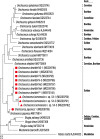Description, molecular characteristics and Wolbachia endosymbionts of Onchocerca borneensis Uni, Mat Udin & Takaoka n. sp. (Nematoda: Filarioidea) from the Bornean bearded pig Sus barbatus Müller (Cetartiodactyla: Suidae) of Sarawak, Malaysia
- PMID: 32028994
- PMCID: PMC7006428
- DOI: 10.1186/s13071-020-3907-8
Description, molecular characteristics and Wolbachia endosymbionts of Onchocerca borneensis Uni, Mat Udin & Takaoka n. sp. (Nematoda: Filarioidea) from the Bornean bearded pig Sus barbatus Müller (Cetartiodactyla: Suidae) of Sarawak, Malaysia
Abstract
Background: The genus Onchocerca Diesing, 1841 includes species of medical importance, such as O. volvulus (Leuckart, 1893), which causes river blindness in the tropics. Recently, zoonotic onchocercosis has been reported in humans worldwide. In Japan, O. dewittei japonica Uni, Bain & Takaoka, 2001 from wild boars is a causative agent for this zoonosis. Many filarioid nematodes are infected with Wolbachia endosymbionts which exhibit various evolutionary relationships with their hosts. While investigating the filarial fauna of Borneo, we discovered an undescribed Onchocerca species in the bearded pig Sus barbatus Müller (Cetartiodactyla: Suidae).
Methods: We isolated Onchocerca specimens from bearded pigs and examined their morphology. For comparative material, we collected fresh specimens of O. d. dewittei Bain, Ramachandran, Petter & Mak, 1977 from banded pigs (S. scrofa vittatus Boie) in Peninsular Malaysia. Partial sequences of three different genes (two mitochondrial genes, cox1 and 12S rRNA, and one nuclear ITS region) of these filarioids were analysed. By multi-locus sequence analyses based on six genes (16S rDNA, ftsZ, dnaA, coxA, fbpA and gatB) of Wolbachia, we determined the supergroups in the specimens from bearded pigs and those of O. d. dewittei.
Results: Onchocerca borneensis Uni, Mat Udin & Takaoka n. sp. is described on the basis of morphological characteristics and its genetic divergence from congeners. Molecular characteristics of the new species revealed its close evolutionary relationship with O. d. dewittei. Calculated p-distance for the cox1 gene sequences between O. borneensis n. sp. and O. d. dewittei was 5.9%, while that between O. d. dewittei and O. d. japonica was 7.6%. No intraspecific genetic variation was found for the new species. Wolbachia strains identified in the new species and O. d. dewittei belonged to supergroup C and are closely related.
Conclusions: Our molecular analyses of filarioids from Asian suids indicate that the new species is sister to O. d. dewittei. On the basis of its morphological and molecular characteristics, we propose to elevate O. d. japonica to species level as O. japonica Uni, Bain & Takaoka, 2001. Coevolutionary relationships exist between the Wolbachia strains and their filarial hosts in Borneo and Peninsular Malaysia.
Keywords: Coevolution; Indomalayan realm; Malayfilaria sofiani; Onchocerca dewittei; Onchocerca japonica; Suidae.
Conflict of interest statement
The authors declare that they have no competing interests.
Figures






References
-
- WHO. Onchocerciasis. Geneva: World Health Organization; 2018. https://www.who.int/news-room/fact-sheets/detail/onchocerciasis. Accessed 30 Jan 2019.
-
- Eberhard ML, Ostovar GA, Chundu K, Hobohm D, Feiz-Erfan I, Mathison BA, et al. Case report: zoonotic Onchocerca lupi infection in a 22-month-old child in Arizona: first report in the United States and a review of the literature. Am J Trop Med Hyg. 2013;88:601–605. doi: 10.4269/ajtmh.12-0733. - DOI - PMC - PubMed
-
- Takaoka H, Bain O, Uni S, Korenaga M, Kozek WJ, Shirasaka C, et al. Zoonotic onchocerciasis caused by a parasite from wild boar in Oita, Japan. A comprehensive analysis of morphological characteristics of the worms for its diagnosis. Parasite. 2004;11:285–292. doi: 10.1051/parasite/2004113285. - DOI - PubMed
MeSH terms
Grants and funding
LinkOut - more resources
Full Text Sources

